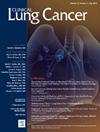肺癌治愈患者随访的系统评价。
IF 3.3
3区 医学
Q2 ONCOLOGY
引用次数: 0
摘要
简介:肺癌患者在治疗意图治疗后的随访应包括改善其生活质量和生存的策略。这些措施可能包括监测和管理癌症治疗的复发症状和晚期毒性,使用患者报告的结果(PRO)工具,以及戒烟干预措施。本系统综述的目的是检查这些随访策略。材料和方法:本系统综述由安大略健康(安大略癌症护理)的循证护理项目开发。MEDLINE、EMBASE和Cochrane图书馆检索了系统评价和随机对照试验(rct),比较不同类型的临床医生、PRO工具、戒烟干预措施和管理策略对成年NSCLC或SCLC患者治疗后的体征、症状、危险因素、合并症或晚期毒性的影响。结果:纳入35项随机对照试验和19项系统评价。对于护士主导的干预,要么发现支持干预的显著影响,要么没有发现显著影响。使用PRO工具的结果是混合的,可能是由于比较器和设置的差异。有证据表明,戒烟干预可能对这些患者有益(RR, 0.84;95% ci, 0.68-1.03)。在目标人群中,体征、症状、危险因素、合并症或晚期毒性的管理证据有限。结论:戒烟干预、运动训练和PRO工具的使用可能对这些患者有益。该系统评价的结果被用于临床实践指南的建议。需要对该患者群体进行进一步的随机对照试验。本文章由计算机程序翻译,如有差异,请以英文原文为准。
Systematic Review for the Follow-up of Curatively Treated Patients With Lung Cancer
Introduction
The follow-up of patients with lung cancer after curative-intent treatment should include strategies to improve their quality of life and survival. These could include the monitoring and management of symptoms of recurrence and late toxicities from cancer treatments, the use of patient-reported outcome (PRO) tools, and smoking cessation interventions. The objective of this systematic review was to examine these follow-up strategies.
Materials and Methods
This systematic review was developed by Ontario Health (Cancer Care Ontario)’s Program in Evidence-Based Care. MEDLINE, EMBASE, and the Cochrane Library were searched for systematic reviews and randomized controlled trials (RCTs) comparing different types of clinicians, PRO tools, smoking cessation interventions, and management strategies for signs, symptoms, risk factors, comorbidities, or late toxicities in adult patients with NSCLC or SCLC after curative-intent treatment.
Results
Thirty-five RCTs and nineteen systematic reviews were included. For nurse-led interventions, either significant effects were found in favor of the intervention, or no significant effects were found. The results for the use of PRO tools were mixed, possibly due to differences in comparators and settings. Evidence suggested that smoking cessation interventions might benefit these patients (RR, 0.84; 95% CI, 0.68-1.03). There was limited evidence in the target population for the management of signs, symptoms, risk factors, comorbidities, or late toxicities.
Conclusions
Smoking cessation interventions, exercise training, and the use of PRO tools may benefit these patients. The results of this systematic review were used to inform recommendations in a clinical practice guideline. Further RCTs in this patient population are needed.
求助全文
通过发布文献求助,成功后即可免费获取论文全文。
去求助
来源期刊

Clinical lung cancer
医学-肿瘤学
CiteScore
7.00
自引率
2.80%
发文量
159
审稿时长
24 days
期刊介绍:
Clinical Lung Cancer is a peer-reviewed bimonthly journal that publishes original articles describing various aspects of clinical and translational research of lung cancer. Clinical Lung Cancer is devoted to articles on detection, diagnosis, prevention, and treatment of lung cancer. The main emphasis is on recent scientific developments in all areas related to lung cancer. Specific areas of interest include clinical research and mechanistic approaches; drug sensitivity and resistance; gene and antisense therapy; pathology, markers, and prognostic indicators; chemoprevention strategies; multimodality therapy; and integration of various approaches.
 求助内容:
求助内容: 应助结果提醒方式:
应助结果提醒方式:


